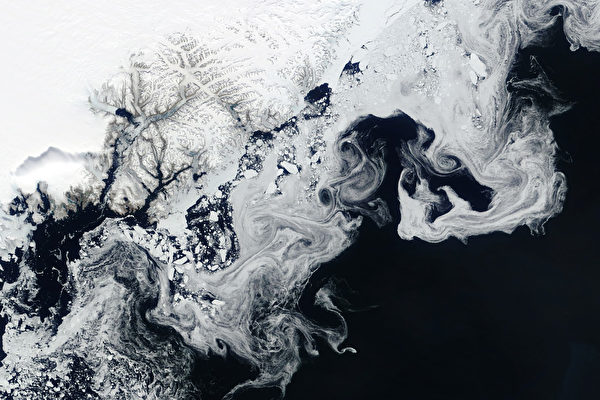The NASA’s Terra satellite captured swirling sea ice along the east coast of Greenland, creating a mesmerizing scene. The satellite recorded floating sea ice fragments on June 4 in the Arctic Ocean, with the East Greenland Current carrying them southward along the eastern coast of Greenland, forming the swirling pattern.
These sea ice pieces drift from the Fram Strait into the Arctic Ocean. The Fram Strait is 450 kilometers wide and serves as a major passage for sea ice to flow out of the Arctic region, located between Greenland and the Svalbard archipelago.
Most of these sea ice pieces may have traveled a significant distance before reaching this area. During the drifting process, the ice breaks down into smaller fragments and begins to melt in the warm ocean water, forming the swirling patterns captured by the Terra satellite.
Walt Meier, a sea ice scientist at the National Snow and Ice Data Center, mentioned that the sea ice fragments in these swirling patterns could be only a few meters or tens of meters wide, too small to be distinguished from the satellite images. Their combination creates the curling patterns resembling smoke on the ocean surface.
Meier explained that the main ocean currents moving south along the coast are influenced by the jagged coastline, other offshore currents, and occasional winds from the Greenland Ice Sheet, forming the visible swirls on the sea surface. The presence of sea ice fragments makes these swirls clearly visible.
He stated, “As the ice becomes thinner and more fragmented, it becomes easier to be pushed by winds and currents.”
Angela Bliss, a sea ice scientist at NASA’s Goddard Space Flight Center, pointed out that in recent years, more sea ice in the Arctic Ocean has become too young and thin to drift southward.
Bliss said, “Historically, when more sea ice in the Arctic survives through the summer melt season and becomes thicker and older, more sea ice moves through the Fram Strait.”
A study published in 2023 showed a decrease in sea ice carried by the East Greenland Current through the Fram Strait, mainly due to the thinning of the ice.
Some climate scientists are closely monitoring this situation because the movement of sea ice and freshwater out of the Arctic region is part of the ocean circulation patterns, which help distribute heat globally.
In a previous report, NASA also captured similar swirling patterns on the eastern sea surface of Siberia, Russia, illustrating how sea ice forms under the influence of winds and ocean currents.

